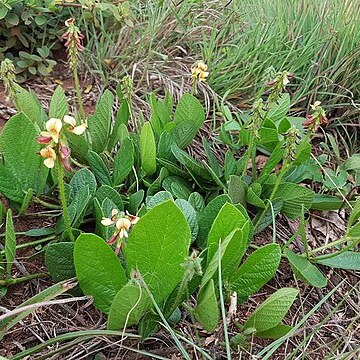The decumbent stem, petioles, peduncles and calyx roughly pilose with spreading, red hairs; leaves subsessile, either solitary, roundish-cordate, obtuse, or pinnato-tri-foliolate, the leaflets elliptic-ovate, all membranous, rufo-pilose on both sides, somewhat bullate, penninerved and veiny beneath; stipules free, broad, ovate-acuminate; peduncles shorter or longer than the leaves, densely spicato-racemose above the middle, the flowers reflexed-imbricate. Less densely hairy; leaves all pinnato-trifoliolate, leaflets membranaceous, elliptic-oblong, acute; peduncles much longer than the leaves, more laxly racemose. Hoot woody. Stems 6-12 inches long or more, subsimple. Leaves either simple or pinnately trifoliolate. The simple leaves are nearly or quite sessile, 4-3 inches long, about equally wide, often nearly orbicular; the unijugate have a common petiole inch long, and the leaflets are smaller and more ovate and subacute. Peduncles 2-6 inches long; the raceme 1-2 inches. Calyx very hairy, the tube 1 line, segments 2 lines long, lanceolate-subulate, the uppermost free. Vexillum 4 lines long, pubescent. Legume orbicular, very oblique, compressed, densely rufo-hirsute. Remarkable for its rough clothing of foxy, rigid, but glossy hairs. Simple and trifoliolate leaves occur sometimes on the same stem.
Perennial, decumbent herb, 0.05-0.60 m high; 1-20 stems from vertical, daucate, woody rootstock; vestiture variable with reddish or white hairs. Leaves unifoliolate and round-cordate (along coastal areas) or trifoliolate and ± elliptic-ovate with basal leaves unifoliolate. Leaflet size and shape very variable, 6-10(-14) mm long, subsessile, membranous, short spreading hairs on both sides. Flowers red and yellow, strongly reflexed, 8-10 mm long. Calyx covered in few, short, stiff hairs; teeth longer than tube. Petals: wings greatly exceed keel; keel white-, yellow-or orange-glandular. Flowering time summer. Pod with short, spreading hairs.
Leaves 1–3-foliolate, the lower ones often predominently 1-foliolate but sometimes all 3-foliolate; leaflets 4.3–13.3 × 1.7–9 cm, the terminal one elliptic to round ovate or lanceolate, the laterals more obliquely oblong-elliptic, rounded to acute or subacute and shortly mucronate at the apex, rounded to slightly or distinctly cordate at the base, sparsely pilose above and more densely so beneath, discolorous or not; petiole 2–4(7 even 20) mm long; rhachis 1–1.6(2.3) mm long; stipules (4)17(23) × (3)5–12 mm, lanceolate, tapering acute, venose, densely hairy, at first connate at the base but often splitting.
A herb. It has a rootstock and one stem arises from this. It can grow 40 cm high. There are 2 leaves. These have 1-3 leaflets. These are large and broad. There is a leaflet at the end. The end leaflet is 10 cm long by 7 cm wide. The flowers are at the end of the stem. There are many flowers on a long stalk. They are yellow. The fruit is a flat pod which is 1.5 cm across.
Corolla yellow and brown or red; standard (8)9(12.3) × 7(9) mm excluding the 2–3 mm long claw, obovate; wings 7(11.5) × 3(4) mm excluding the 1–2 mm long claw, oblanceolate-obovate; keel petals 7(8.5) × 2.8(4.5) mm excluding the 1(2.8) mm long claw, oblong-rhombic, very densely gland-dotted at tip.
Perennial herb, up to 0.6 m high. Stems procumbent, densely pubescent with spreading hairs. Leaves (1-)3-foliolate; leaflets large, up to twice as long as broad; stipules connate. Flowers: corolla yellow and red or brown; Sep.-Jan. Pods ± 20 mm long, densely hairy.
Inflorescences 2–5.5(10) cm long; peduncle 3–20.5 cm long, hairy as on stems, occasionally with 1–2 stipuliform bracts 8 × 2 mm; floral bracts 9 × 2.5 mm, lanceolate, soon falling; pedicels 1 mm long.
Flowers deflexed; calyx pilose, the tube 3.5–5 mm long and lobes 3(7.5) mm long, triangular to triangular-lanceolate.
Pods blackish, 1.6–1.7 × (0.9)1.1–1.3 cm, oblong-elliptic; seeds black, (3)6 × (2.4)3.5 mm, oblong with pale hilum.
Prostrate, ascending or rarely erect herbs, (5)12–45(60) cm long, from a woody rootstock 15–23 × 1–1.5(?10) cm.
Stems densely hairy with ± spreading bristly white or ± ferruginous hairs c. 3 mm long.


